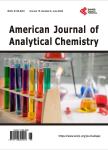Method Validation for SPE Applied to Determination of PAH in Petroliferous Industry Effluent Water
Method Validation for SPE Applied to Determination of PAH in Petroliferous Industry Effluent Water作者机构:不详
出 版 物:《American Journal of Analytical Chemistry》 (美国分析化学(英文))
年 卷 期:2011年第2卷第8期
页 面:971-978页
学科分类:1002[医学-临床医学] 100214[医学-肿瘤学] 10[医学]
主 题:Produced Water Effluent PAH SPE
摘 要:The presence of polycyclic aromatic hydrocarbons (PAH) in produced water is of environmental concern due to their toxic properties. PAH analysis in complex samples requires pre-treatment to enrich the fraction con- taining analytes, and eliminate matrix interferences. The objective of this work was to develop and validate an analytical methodology for determination of PAH in produced water, using solid phase extraction (SPE) and analysis by gas chromatography with flame ionization detection (GC-FID). Average recoveries of PAH from produced water enriched at two concentration levels varied from 30.9% for naphthalene to 119.1% for chrysene (RSD between 3.8% and 22.2%). The linear range was between 0.5 and 50.0 μg?mL–1, with regres- sion coefficients better than 0.998. Detection limits were between 0.01 and 0.04 μg?L–1, and quantitation lim- its were between 0.05 and 0.16 μg?L–1. The validated method was applied to samples of produced water treated for disposal, in which concentrations varied from 3.5 μg?L–1 for phenanthrene to 44.3 μg?L–1 for naphthalene ( = 177.7 μg?L–1). The method was also applied to seawater samples, in which 13 PAH compounds were detected ( = 60.27 μg?L–1), probably derived from pyrogenic sources.



